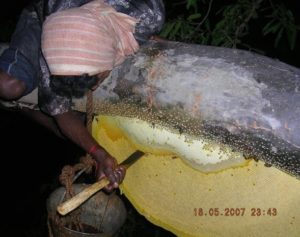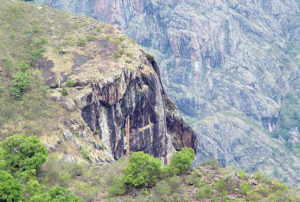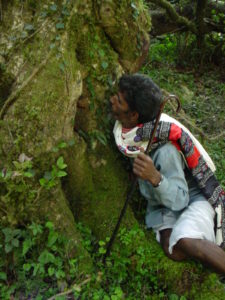Traditions that incorporate conservation practices
The practice of wild honey collection, even when done with the utmost regard for the environment and natural systems, still has a negative impact on the honeybees in the end. The very apparent harmful impact is the fact that the honey is the main source of food for the honeybees, especially for the brood. Honey hunting is even more harmful when it is done out of complete disregard for the honey bees. For instance, some honey hunting has involved the destruction of an entire hive by putting direct fire on the comb, thus much of the brood and adult bees will be killed. However, there are ways in which the varying tribes of the Nilgiris have sought to make their practices more sustainable. For example, most honey hunters nowadays will only put smoke near the hive to encourage them to temporarily abscond the nest, as opposed to directly burning the colony.
Since the honeycombs on cliffs are at a 45 degree angle, only part of the hive attached to the cliff will have the honey. Thus, with proper dexterity (of course, while dangling from a cliff) a skilled honey hunter can stab out only the honey portion of the comb and leave the rest of it attached to the cliff, which is comprised of the brood.


This method can also be done on a tree if part of the brood section (non-honey comb) is attached to the branch. By not bringing down the whole comb this ensures the survival of the next generation of the colony and the insurance of sustaining that species.

There are some sustainable practices of honey hunting that are as ancient as the relationship between the people and their connection with the honeybees. One such practice can be referred to as God Cliffs. Among the handful of Nilgiri tribes who honey hunt on cliffs, they will designate some of the cliffs as sacred and strictly leave them untouched. This is done out of spiritual consideration with the cliff being believed to have a divine connection. However it is also an intentional way to maintain ecological balance by allowing some colonies to thrive and regenerate. This help to ensure that these honeybees return every year and that the species will be sustained.

Among the Toda tribe, there is a distinct practice with honey hunting. They are highly skilled at collecting honey from the parallel combs of Apis cerana found within tree cavities. When they collect the honey there is no use of smoke or tools to harvest the honey comb. Rather they breathe into the cavity to move the bees and keep them calm, then stick one hand inside and pull out only the honey comb. Any of the combs with the bee brood is left untouched. This system of wild collection is even more ecologically sound given no irritants, such as smoke, are used. Sometimes with cliff hunting, it is only possible to collect honey by bringing down an entire hive, thus harming all the brood of that hive. This method ensures that most of the brood will survive.
There is also an awareness that honeybees prefer healthy forests. If the forests are not healthy then there will not be a surplus of flowering plants for the bees to collect nectar from and to pollinate. As stated before, honeybees need to collect nectar and make honey for themselves as a food source, thus when resources are not available they leave that area to find what they need. For the past few years, the number of combs in the Nilgiris have reduced in conjunction with the gradual felling of forests. All these natural systems are interconnected, so forests must be maintained in a healthy state for the honeybees to thrive and for the people to have a honey source.
Spiritual connection in relation to honey hunting
Honey Hunting is to collect wild honey, a NTFP (non-timber forest product) that supplies a necessary nutritional source to the people who gather it. Honey hunting is a means to make a profit, a direct supply and demand between those who collect this honey and those who want to consume this sweet commodity from the forest. Honey Hunting is also a deeply spiritual process, one that has developed for thousands of years alongside the practice itself and still remains significant today.
Before the honey hunting season begins, even weeks prior, there are several rituals that must be done. The honey hunters will do weeks of fasting, daily prayers to the spirits for blessings on the upcoming honey hunt, and will bathe often. Some of these honey collectors will even go so far as to remain abstinent until the season comes. The goal is to obtain excellent focus for the intense experience of honey gathering, especially in regards to cliffs. It is impertinent to be cleansed not only of the body but also the mind, as in one must approach the honey hunt with pure thoughts. The indigenous groups who practice honey hunting have a strong regard for the forest and a belief that the forest deities who dwell there strongly favor honey hunting.
As the season approaches, the priest of the village (pujari) will be consulted to set a date and time for when the honey hunt should begin. Cliff hunting is given even further spiritual regard such that the cliff climbers call the rock (the cliff) their mother, the rope their father, and the tree on top of the cliff their older brother. Cliff hunting is incredibly risky and requires great trust in one’s own ability and those of one’s teammates. With a strong belief in the forest deities, and that they have a say over how well the honey hunt goes, it is no wonder that the nature and tools are regarded in such a familial manner.
There is even a spiritual practice with the tools. For example, in some instances materials such as iron will be prohibited from use and only bamboo will be allowed as a stabbing tool. It is believed that if iron is used to cut a honey comb then the following year, on the same tree, honey will not be produced again. One of the most unique spiritual practices in regards to honey hunting is that only specified cliffs will be harvested while the rest are left untouched. The cliffs that will not be harvested for their honey are called God Cliffs – there is a strong belief that only certain cliffs should be used for honey collection while the others have a divine connection and should be regarded with reverence.
Bee Songs
Spiritual songs are also a significant part to this process. During a climb, mantras will be sung to help protect the honey gatherers from bee stings. They often tell of the relationship between the honey hunter and the honeybee, as well as are a way to connect and show respect to nature. Songs are also sung after successful honey harvest, while eating honey and even bee brood collected from the combs, as a way to celebrate in the village a good honey collection. Below are a few examples of song, their recordings, and translations. As this website progresses, hopefully too will the recordings of these songs increase:
Bee Song sung by Ramichandran
Kunna Athige Kacha Beda
Dhodda Athige Kacha Beda
“Younger sister don’t bite me
Older sister don’t bite me”
Kurumba Song for honey hunting
The text will go here




